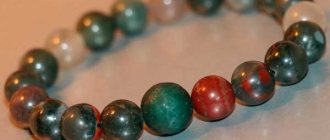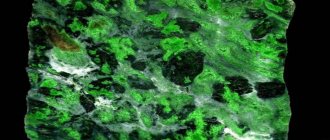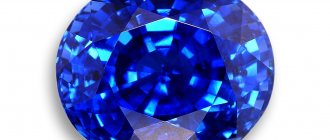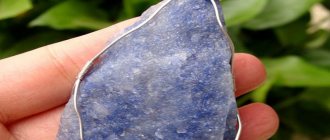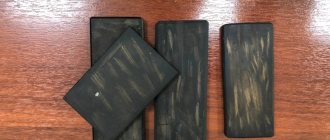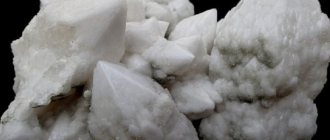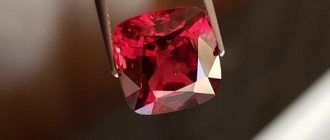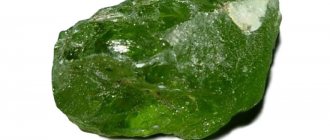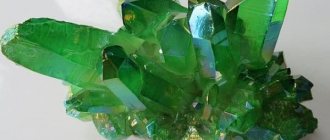The stone has another name - kisthen, which means “double strength” translated from Greek. We will tell you why it was called that and what properties the mineral has in this article. Like most stones, disthene can either exhibit beneficial properties or destroy the wearer. In order not to receive a “cursed” amulet, you need to know who kyanite is suitable for by character and zodiac sign. Let's find out.
Story
The stone was introduced to Russia and Europe in the 16th century by merchants who brought it from India.
Kyanite is one of the few minerals whose names are known exactly:
- 1789 The German geologist and mineralogist Abraham Werner, without further ado, dubbed it kyanos (κυανός in Greek means “blue”). Although in its homeland it was a “plank stone”: a long crystal-column in shape and texture really looks like a piece of board.
- His French colleague René Haüy, taking into account the duality in the formation of crystals, coined the term “ dysthene ” - “dis sthenos” (“double strength”) in Greek.
- In Rus', the mineral was known as “baus” - named after Jeremiah Baus. This London merchant specialized in precious stones during the reign of Ivan the Terrible. At that time, almost all precious stones were called bausses.
Among gemologists and collectors, the terms kyanite, reticite, xantholite, beryl-azul (that is, blue beryl), sapphire spar, cyanite are in use.
Nepalese kyanite, cut into oval shape
Well-polished blue kyanite was passed off as sapphire five centuries ago.
Physico-chemical characteristics
To a chemist, the mineral kyanite is an aluminum silicate. The second main component of the formula is silicon oxide.
| Formula | Al2O(SiO4) |
| Color | Blue, green, yellow, violet, colorless, black |
| Stroke color | White |
| Shine | Glass (pearl) |
| Transparency | Transparent, translucent |
| Hardness | 4—7 |
| Cleavage | Perfect by {100} |
| Kink | Splintered |
| Density | 3.56—3.67 g/cm³ |
| singonia | Triclinic |
| Refractive index | 1,72 |
A couple of percent of the composition remains as impurities: iron, manganese, chromium, titanium. They create the color scheme of the stone.
The classic color of kyanite is blue or blue. Less common are white, black, yellow, and green specimens.
The structure of kyanite gives rise to fluctuations in hardness: from 5 (can be scratched with a knife) along the prism crystal to 7 (not scratched) across. This “anomaly” makes kyanite stand out among gemstones.
Description
It is a rock-forming mineral that is formed in different ways:
- During the process of metamorphism of alumina-rich sedimentary rocks at depth.
- Specimens of igneous origin are found in pegmatites and granites.
- Hydrothermal kyanite fills quartz veins, but these are extremely rare cases.
Color is the basis for the classification of stone into varieties.
A special case is specimens with a “cat’s eye”. Rarely, but there is an alexandrite effect - a change in color from different angles of view. Kyanite ranges from blue to violet or green.
Compatibility with zodiac signs and names
Astrologers advise the gem:
- Pisces to combat unjustified modesty;
- Cancer to control impressionability;
- Libra for decision making;
- Sagittarius, Gemini for development, following the chosen path;
- Taurus, Aries to increase internal energy;
- Aquarius for protection from evil.
The mineral will not help those born under the zodiac sign Capricorn.
The breed patronizes male names Petya, Vitya, Gosha, Gena. It is recommended as a talisman for Ulyana, Vasilisa and Evdokia.
Kyanite - Peter's talisman
Place of Birth
Kyanites are mined on all continents:
- America – USA, Brazil;
- Asia - Myanmar, Nepal, India;
- Europe – France, Switzerland, Austria, Spain;
- Africa – Madagascar, Kenya, Tanzania;
- Australia.
Only in Kenya is green kyanite mined today. Although the world's first such pebble was found in Yakutia. Nepal supplies bright blue stones that are visually indistinguishable from sapphires.
Russian deposits are concentrated in the Urals (blue stones) and the Kola Peninsula (purple stones).
Industrial development of raw materials is established in India and the USA.
Origin
In crystalline schists and gneisses, in metamorphic rocks.
Kyanite is found in kimberlites, pegmatites, hydrothermal and alpine veins.
In nature it occurs in the form of plate-like elongated crystals.
Where is the stone used?
Kyanite has a value for a person as useful and pleasing to the eye. Demanded by jewelers, but the main area of application is serious industries.
Industry
As a good fire- and acid-resistant material, kyanite is used in the production of products for civil and defense purposes:
- insulators, electroporcelain;
- enamels;
- car spark plugs;
- crucibles for steelmaking;
- refractory cement;
- plastics;
- household plumbing: bathtubs, sinks, tiles.
The significance of the stone is evidenced by the following fact: in the USA, kyanite is classified as a strategic raw material.
This is a glass additive that increases the percentage of aluminum. From kyanite, the silicon-aluminum alloy silumin is obtained - a material for aircraft and mechanical engineering, and pneumatic weapons.
Jewelry
Jewelers get the most “tidbits”: beautiful transparent specimens reminiscent of sapphire.
Ring with kyanite
Although they do not particularly honor the semi-precious stone: it is too troublesome to process:
- Masters prefer blue or green crystals - they are the densest and refract light better than other kyanites. That is, they shine.
- More often, crystals are polished cabochon or lightly faceted, resulting in necklaces, beads, bracelets, ring inserts, and earrings.
- Popular parures are earrings + ring, earrings + pendant + ring.
It is better to wear jewelry with kyanites during the day: they look more advantageous. Especially in a silver frame.
In addition to silver, the gem is framed with gold, cupronickel or a jewelry alloy of white shades.
Other areas
Collectors of stone collections dream of adding yellow, green and black stones to their collections.
Among the most popular kitchen products is a countertop made of chipboard in a kyanite shade.
Application
Stone is quite important for human production activities.
Application of the mineral in various fields of industry:
- Fireproof and acid-resistant materials.
- Production of ceramics and products made from it (tiles, sinks, bathtubs).
- Crucibles for steel casting.
- In the creation of aluminum-silicon alloys.
Jewelry examples of kistene are not found very often. But they are extraordinarily good. No wonder kyanite was sometimes sold as sapphire.
Kyanites are often cut into cabochons. The stone acquires a pearlescent shine and mesmerizing depth.
It’s sad: kyanite is practically unknown in Russia. The difficulty of processing the stone, the lack of official mining - and as a result, excellent examples of kyanites do not find their buyers. Jewelers prefer stones that are easy to process, “more in number, cheaper in price.” We recommend: Heliotrope or Bloodstone - a strong mineral with dark beauty and inclusions
How to spot a fake
Kyanite cannot be purchased everywhere, so it is rarely counterfeited. More often he himself becomes a “understudy” for more expensive gems. To do this, white or colorless crystals are colored, polished, and blue kyanite is sold under the guise of sapphire. Bluish-green specimens are mistaken for aquamarine.
You can identify a sapphire or aquamarine in the light: the color of these gems is uniform, while kyanite has a striped color.
To distinguish it from a fake made of glass, the properties of the mineral are taken into account:
- under ultraviolet light, natural kyanite glows red - weakly or moderately;
- does not luminesce under the influence of x-rays;
- the blowpipe does not melt it.
In 1955, artificial kyanite was synthesized. But it is used as technical raw material.
Kyanite mineral change
Paramorphoses of andalusite and sillimanite kyanite are described. The replacement of kyanite by andalusite, cordierite and muscovite is associated with thermal metamorphism. During retrograde metamorphism, kyanite was replaced by a mixture of corundum and oligoclase (thin reaction rims) and partially replaced by p-zoisite. Under the influence of high-temperature aqueous solutions, kyanite transforms into muscovite, sericite, and less commonly, talc, diaspore, pyrophyllite, paragonite, dickite, xanthophyllite, kaolinite, quartz, margarite, clinozoisite, and topaz develop along it.
Magic properties
The magical properties of kyanite have been thoroughly studied by esotericists.
Natural kyanite cabochons
Overall Impact
The stone is useful in various everyday vicissitudes:
- Kyanite helps you find yourself and your life's work. Therefore, the significance of the stone will be appreciated primarily by young people. It is also worth meditating on it for older people who are dissatisfied with their work.
- The owner of the mineral becomes reasonable, calm, and charismatic. Thanks to this, his personal authority will increase and new acquaintances will appear.
- However, the stone does not allow you to skid.
Kyanite is a good gift for a person with an exorbitant sense of self-importance: it will help to evaluate oneself realistically.
- The kyanite talisman strengthens memory, instills a love of science and knowledge of the secrets of life. Its owner will begin to strive for self-improvement.
- The magic of the stone is especially useful for “multi-toolers” and absent-minded people: it will be easier for them to concentrate on one, main problem, and solve it without working too hard.
- The blue range of the stone promotes nervous calm, sound sleep and a philosophical attitude towards troubles.
However, flighty or deceptive people should be careful with the mineral: kyanite will “force” the owner to be truthful and faithful.
Talismans
Magicians warn that the stone only helps in projects with a plus sign:
- As a symbol of constancy and fidelity, it is recommended that businessmen carry it with them. Especially during negotiations or when signing contracts. Earrings, necklaces, rings can neutralize the deceit and evil intentions of business partners.
- The energy of the stone helps public figures, teachers, servants of Themis, and doctors to remain calm.
- The property of crystal-prisms to turn their sharp end to the north is used by solo travelers or extreme sports enthusiasts.
- Creative people should wear some product if inspiration “fell asleep.”
Beads with kyanite
You don’t need to wear the mineral all the time to avoid despondency.
Form of being in nature
The appearance of crystals. Columnar, plank, crystals, fibrous, radiant, foliated discharges.
Doubles
Doubles are common according to different laws. The most common are twins with a twin plane (100) and with twin axes (100) or [001], often polysynthetic; There are also twins with twin axes [010], [010], [001], [140]; cross-shaped twins of germination with a twinning axis are rare (121). The crystals are sometimes twisted or curved; Almost exclusively the (100) faces are subject to bending, and with repeated bending, both ends of the crystal in most cases remain parallel to each other.
Crystal intergrowth
Parallel intergrowths of crystals along (100) are known. Kyanite forms regular intergrowths with staurolite, in which the (100) face of kyanite || (010) of staurolite, which is explained by the similarity in the arrangement of atoms on flat networks corresponding to these faces. Sillimanite needles were observed on the (100) faces of kyanite; the c axes of both minerals are parallel; Such intergrowths are explained by the fact that along the c axis of the two minerals the chains of aluminum octahedra have almost equal repetition periods. Regular intergrowths of kyanite with andalusite were also observed, the c axes of the minerals being approximately parallel (deviation up to 30°). Regular intergrowths of kyanite with ioderite (the b axis of ioderite is parallel to the c axis of kyanite) and diablast structures of kyanite intergrowth with monoclinic pyroxene are noted. Along the pinacoid plane, kyanite forms intergrowths with muscovite. Kyanite often contains quartz inclusions. In addition, there are inclusions of mica, rutile, ilmenite, staurolite, sillimanite, tourmaline, iron luster, garnet, sapphirine, graphite, magnetite, sulfides, etc. The richest in inclusions is kyanite from shales; Kyanite from zones of repeated recrystallization has the smallest number of inclusions. Kyanite also contains liquid inclusions, which were studied in detail using material from metamorphic rocks and pegmatites of the Maysky region of North-Eastern Transbaikalia. Liquid inclusions are located along the cleavage plane and occasionally along healed cracks at an angle to the cleavage. The shape of the inclusions is flat, elongated, sometimes tubular or in the form of negative kyanite crystals. In terms of composition, inclusions are two-phase (Zhso2 + Zhrast), single-phase (inclusions of liquid carbon dioxide) and multiphase (Zhs02 + Zhrast + Tsol).
Aggregates. Crystals, grains, veined, sheaf-shaped and radial aggregates.
Therapeutic effect
Lithotherapists highlight the following medicinal properties of kyanite:
- It is useful to wear jewelry with it for emotionally unstable, hypersensitive or “forgetful” people.
- The stone gives strength and increases the overall tone of the body.
- Calms fever and pain of various natures. To do this, apply a pebble to the sore spot.
- Fights infections, colds, ARVI, acute respiratory infections.
- The positive effects of the stone will be felt by people with problems with the kidneys, genitourinary system, and thyroid gland.
- Hypertensive patients are advised to apply a piece of stone to the chest and center of the forehead.
- The blue mineral is a powerful “pediatrician.” It protects against infections, neutralizes insomnia and anxiety, to which children and adolescents are especially susceptible. A pendant or pendant is suitable for them as a talisman.
Kyanite speeds up metabolism, which is useful for people on a diet or overweight.
The best healing artifact is a silver ring or ring with a gem.
Gentle care - long life of jewelry
The stone is capricious and fragile. Along the low hardness axis, it splits easily.
Therefore, a competent jeweler will be cautious about the idea of making a ring with disthene. You will need to wear it carefully, carefully, and not drop it.
The best jewelry with kyanite are earrings, brooches, pendants, and necklaces.
It is important to take good care of your jewelry. They do not tolerate ultrasonic and steam cleaning. Wash soiled jewelry the old fashioned way, with water and neutral shampoo.
Price
Russian online stores offer an assortment of products (price/rub.):
- earrings (silver, insert dimensions 12x16 mm) – 6,400;
- ring (silver, insert diameter 12 mm) – 3,500;
- bead (10 mm) – 186;
- cabochon (12 mm) – 960;
- tumbling (35–45 mm) – 540–630;
- untreated stone (70–120 mm) – 840 – 1,860.
Almost all the material is from Brazil, Minas Gerais.
The price per carat of processed gemstone in Russia is 2,268 – 9,719 rubles, depending on the size and color saturation of the stone.
Questions/Answers
We are interested in looking for answers to your questions. We are always happy to receive your questions!
How to distinguish a fake?
Kyanite itself can be passed off as sapphire (and the difference in price is very noticeable).
In its faceted form, kyanite can be confused with aquamarine, benitoite, dumortierite, and cordierite.
But disten is also counterfeited. Checking the crystal:
- The distribution of color is often uneven: zonal, spotty with concentration in the center. Counterfeits do not have this feature.
- A steel knife scratches the crystal along the elongation, but not in the transverse direction. This property makes kyanite unique among minerals.
- Any specialist can easily distinguish kistene from sapphire and aquamarine by density and refractive index.
How to care?
- Protect from shocks and falls.
- Wash contaminated jewelry with soapy water and rinse under running water. Do not use brushes or abrasives.
- Do not store near heating devices.
- Disten does not like bright sunlight.
How to wear?
Do you like rings? Then this information is for you.
Each finger is associated with a specific element:
- index - Fire;
- middle - Earth;
- nameless - Air;
- little finger - Water.
By putting a ring with a Fire stone on your index finger, you will enhance the magical properties of the stone.
What is the price?
In the online store. We look at the display case (in the sense, at the table
